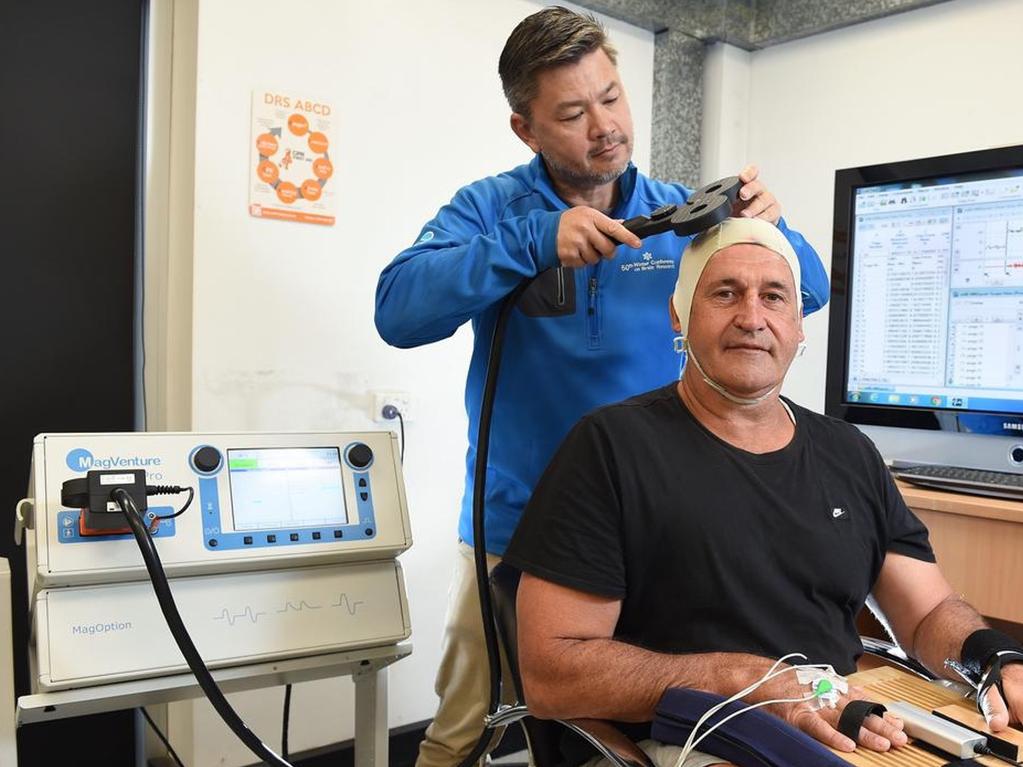Swinburne study links career length, not just concussions, to CTE risk
A study on former NRL and AFL players has prompted a renowned concussion expert to issue this warning about junior sport.

Parenting
Don't miss out on the headlines from Parenting. Followed categories will be added to My News.
EXCLUSIVE
A renowned concussion expert has issued a warning about children playing contact sports after new research found the length of an athlete’s career — from junior levels through to post-retirement—may be a better predictor of Chronic Traumatic Encephalopathy (CTE) than their concussion history.
The groundbreaking study from Swinburne University monitored the brain function of 113 living ex-AFL and NRL athletes between 28 to 68 years old over a five-year period using transcranial magnetic stimulation (TMS).
While often used to treat depression, TMS can also be used as a research technique to measure intracortical inhibition – the process in the brain that helps control and balance activity.
The study found the process most impaired in players who had the longest careers, raising their risk of CTE.
Swinburne University Adjunct Professor Alan Pearce said it was the first time researchers had considered a player’s entire career - from time spent playing in junior to post-retirement leagues - when measuring their brain impairment.
“In my previous research we looked at a player’s risk (of CTE) according to the number of times they had been concussed,” Professor Pearce said.
“What we were finding is that a player who had been concussed 10 times was at no greater risk than a player who had only been concussed twice.
“But in this study what I found quite unexpectedly was the correlation between brain impairment and the total lengths of their careers – not just their concussion history or the amount of time they had played professionally.”
While only an exploratory study – meaning it cannot be used as the basis of medical treatment – the findings support emerging evidence that exposure to any head impact overtime, not just concussions, increases the risk of CTE.
Prof Pearce said the findings impact anyone who had played contact sports, especially those who started from a young age, even if they had never experienced concussion.
“The players in the study started playing full-contact sport at seven years old, they play professionally and then go to their local clubs to play in retirement,” Prof Pearce said.
“Over that time they’re experiencing not just concussion and big hits, but thousands of these little hits, bumps and tackles.
“Think about skin cancer – if you get badly burnt once or twice it’s not great, but it doesn’t necessarily mean you will develop a melanoma. But if people have been sitting out in the sun every weekend for 20 years, and had never been burnt, they are at heightened risk.
“The same goes for CTE. It’s about looking at the cumulative effect of all kinds of head impacts rather than the occasional bad concussion.”
Concern about the degenerative brain disease has grown in recent years after several high-profile athletes including AFL greats Danny Frawley and Shane Tuck were diagnosed post mortem.

Prof Pearce said the study should serve as a wake-up call for reducing the risk of head impacts at a grassroots and club level.
“One of the things (researches) have talked about internationally is to try and modify our sports for children so they are non-contact until the age of 14,” he said.
“This is sensible consideration, as raising the age would take out eight to ten years of potential exposure to head impacts and reduce the risk significantly.”
Prof Pearce also backed calls to monitor and reduce contact load training during the pre-season training period, as per the recommendations of the Shane Tuck Death Inquest.
One study subject, former AFL star Rod Owen, wants the AFL to go one step further – banning tackling entirely.
“The AFL is never going to stop concussions the way the current game is played,” Mr Owen said.
“When people are going for marks they’re using different ways to injure people.
“When the coaches I had were instructing us players to knock out opponents, stop them at all costs, take them out … I can’t believe (the AFL) think they aren’t to blame for the violence.”
The champion player, who played 60 games for the Saints, was introduced to Prof Pearce after reporting symptoms including irritability, struggles with focus, temperament and fatigue.
His TMS data showed he was at risk of developing CTE – a reality that for him did not come as a surprise.
“The number of knockouts I’ve had on and off the field … I can’t do much now so all I can do is live life as much as I can,” Mr Owen said.
Wanting to do something for “current players and players of the future”, Mr Owen has pledged his brain to the Australian Sports Brain Bank for post-mortem research.
Prof Pearce said contributions from former players like him were invaluable for further treatment research.
“We need more players like him,” he said.
“There’s a lot of work to do and we can only do it if other players step up.”
More Coverage
Originally published as Swinburne study links career length, not just concussions, to CTE risk








